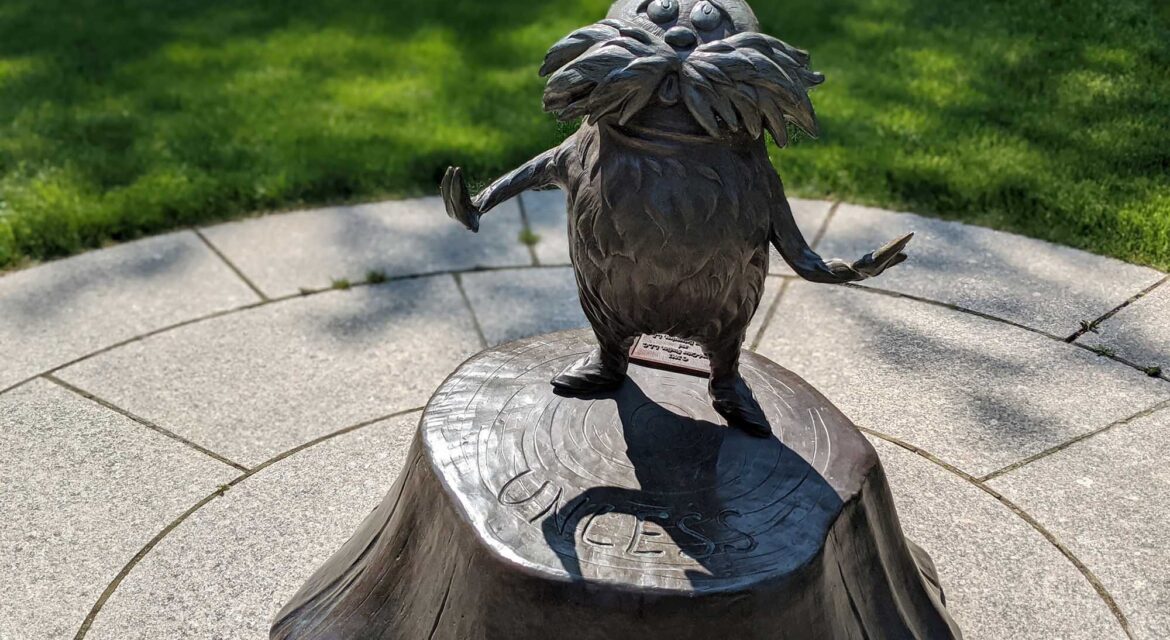 The Dr. Seuss National Memorial Sculpture Garden allows visitors to meaningfully engage with various characters from his beloved stories. Located in Springfield, Massachusetts, the sculpture garden literally brings to life the imagination that has inspired millions of readers, highlighting the power of monuments to personify and celebrate such concepts for the benefit of audiences and stakeholders.
The Dr. Seuss National Memorial Sculpture Garden allows visitors to meaningfully engage with various characters from his beloved stories. Located in Springfield, Massachusetts, the sculpture garden literally brings to life the imagination that has inspired millions of readers, highlighting the power of monuments to personify and celebrate such concepts for the benefit of audiences and stakeholders.

Defining the Amazing World of Dr. Seuss
 Theodor Seuss Geisel wrote and illustrated more than 60 children’s books under the pen name of Dr. Seuss. His most popular stories include The Cat in the Hat, The Lorax, Horton Hears a Who, Green Eggs and Ham and How the Grinch Stole Christmas. Born and raised in Springfield, he died in 1991.
Theodor Seuss Geisel wrote and illustrated more than 60 children’s books under the pen name of Dr. Seuss. His most popular stories include The Cat in the Hat, The Lorax, Horton Hears a Who, Green Eggs and Ham and How the Grinch Stole Christmas. Born and raised in Springfield, he died in 1991.
Not long after his death, his wife Audrey authorized the creation of a national memorial with the Springfield Museums and provided major support for the project. In 1996, his stepdaughter, Lark Grey Dimond-Cates, was selected to make over 30 bronze statues for the Museums’ grounds to sit in the center of the quadrangle formed by the Springfield Museums. The sculpture garden was officially opened in 2002.
On the fifteenth anniversary of the opening of the Dr. Seuss National Memorial Sculpture Garden, the Amazing World of Dr. Seuss opened its doors. The Dr. Seuss National Memorial Sculpture Garden directly enabled this expansion of the Springfield Museums, creating engagement with an audience that has defined a notable impact on the culture and economy of the city.

A Sense of Wonder
 The Dr. Seuss National Memorial Sculpture Garden features five large bronze statue collections, each of which has a connection to a Dr. Seuss Story. Audiences can interact with and instantly recognize these three-dimensional characters and scenes, but their often unexpected positioning and placement throughout the garden cultivates a further sense of wonder.
The Dr. Seuss National Memorial Sculpture Garden features five large bronze statue collections, each of which has a connection to a Dr. Seuss Story. Audiences can interact with and instantly recognize these three-dimensional characters and scenes, but their often unexpected positioning and placement throughout the garden cultivates a further sense of wonder.
Dr. Seuss himself is depicted with the Cat in the Hat standing next to him. They reside near an empty chair in front of a large book with the text of Oh, the Places You’ll Go! The Grinch and his dog, Max, stand near the oversized book.
The largest piece in the sculpture garden depicts the Horton Court, with Horton the Elephant from Horton Hears A Who stepping out of an open book along with various other ancillary Dr. Seuss character. Statues of the Lorax as well as a 10-foot-tall tower of turtles from Yertle the Turtle and Other Stories reside near different entrances to the space.
Additionally, various other sculptures that are not directly connected to the creations of Dr. Seuss are located throughout the space. Some of these pieces have a history with the Springfield Museums that stretches back for many years, connecting the past and present of the space in seamless manner.
The connection of Dr. Seuss to the space and city is evident in multiple ways, with maps and markers guiding audiences to the location. Imagery associated with this creativity is also on display throughout the Springfield, creating a strong sense of identity with and for it. Doing so has created opportunities that will continue to positively influence the Springfield Museums and the entire region.

The Opportunities Created by Imagination
 More than 3 million people have visited the Dr. Seuss National Memorial Sculpture Garden at the Springfield Museums since it opened. The creation of an entire museum dedicated to Dr. Seuss’s life and work right next to the sculpture garden showcases how many different opportunities can be enabled when a legacy that so many people can connect with is celebrated in such an imaginative manner.
More than 3 million people have visited the Dr. Seuss National Memorial Sculpture Garden at the Springfield Museums since it opened. The creation of an entire museum dedicated to Dr. Seuss’s life and work right next to the sculpture garden showcases how many different opportunities can be enabled when a legacy that so many people can connect with is celebrated in such an imaginative manner.

